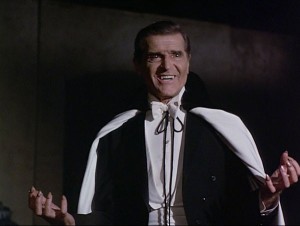In the 1942 film, Berlin Correspondent, Dana Andrews plays Bill Roberts.
Bill is an American journalist, working out of Berlin. Because the film takes place before America’s entry into World War II, Bill pretends to report only what the Germans want him to report. Even while there are bombs exploding outside of the studio, Bill and his fellow correspondents report that everyone in Berlin is happy and that the German government is doing a great job.
However, Bill fills his reporting with code words, which are then interpreted by listeners in the American Intelligence service. They understand that when Bill says that the people are happy, that means that they’re actually miserable. When Bill says that the weather in Berlin is cloudy, that means that there is dissent brewing in the government.
Still, Captain Von Rau (Martin Kosleck) comes to suspect that Bill might be sending out secret messages and he decides to send someone to not only compromise Bill but to also discover who is feeding Bill information. Von Rau sends his own fiancée, Karen Hauen (Virginia Gilmore), to seduce Bill. Little does Von Rau suspect that Bill’s source of information is Karen’s own father (Erwin Kalser) and that Karen herself is going to end up falling in love with Bill.
Berlin Correspondent is typical of the films that were made to try to build support for the American war effort during the Second World War. The hero is a tough and cynical American who pretends to not care about what is happening in the rest of the world but who eventually reveals himself to be an idealist with a strong sense of right and wrong. Bill may say that he’s only in Berlin to report the news but, when Karen’s father is sent to a concentration camp, Bill proves himself to be willing to risk his own life to help the older man make it to Switzerland. Karen’s father stands in for the members of the German resistance who worked from the inside to bring down the Nazis. Bill and Karen’s love serves as a reminder that the world can come back together but only after Hitler has been defeated.
The two main Nazi villains are played by Martin Kosleck and Sig Ruman, two German actors who immigrated to the United States to escape the real-life Nazis. Kosleck and Ruman play their characters as being buffoonish bullies who are easily outsmarted by street smart Americans like Bill. It’s the film’s way of saying to the audience, “Are you really going to let these idiots think that they can defeat America?” Still, a scene is included in which a crippled girl is described as being someone who should be put to death. It’s a necessary reminder that the Nazis may be idiots but they’re also a legitimate threat.
Berlin Correspondent clocks in at a brisk 70 minutes and it features a typically strong leading performance from Dana Andrews. If you needed someone to fight for America, 40s-era Dana Andrews would definitely be a good pick to go with. It’s a joy to watch him outsmart the Nazis.









